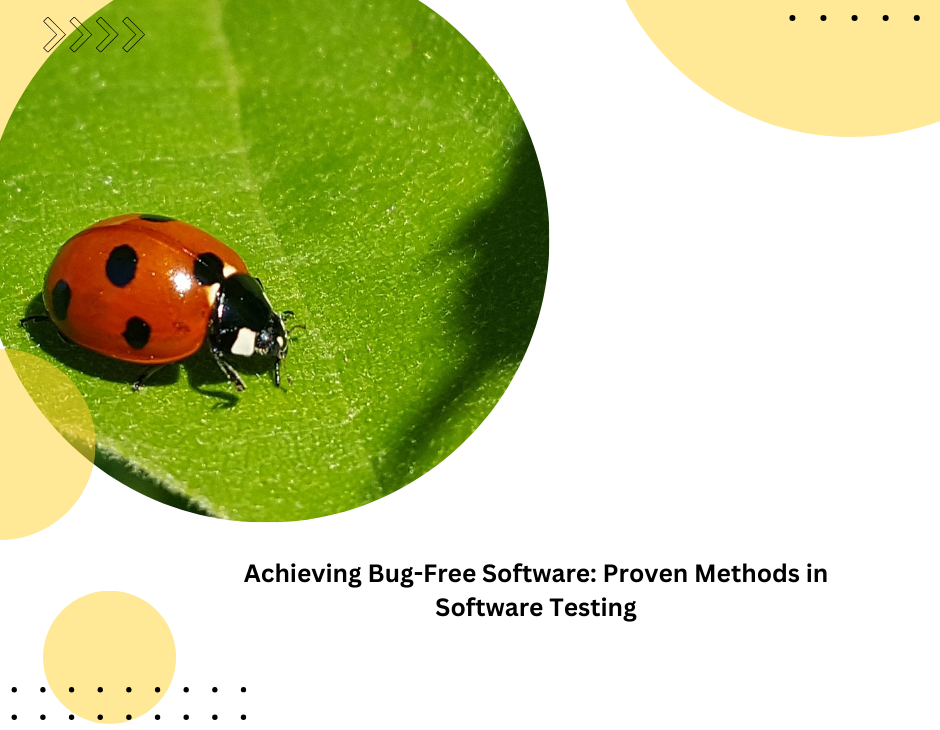Software testing is a critical process in software development that ensures the quality, functionality, and reliability of a product before it reaches users. Achieving bug-free software may seem like an elusive goal, but with proven methods in software testing, it is possible to significantly minimize bugs and deliver a high-quality product. This article will discuss various strategies, techniques, and best practices that software development teams can employ to achieve near-bug-free software.
Why is Software Testing Important?
Before diving into the specific methods, it is essential to understand the importance of software testing:
- Improves Quality: Testing helps identify and eliminate bugs, ensuring that the software functions as intended.
- Enhances User Satisfaction: Bug-free software offers a better user experience, leading to higher customer satisfaction.
- Saves Time and Cost: Fixing bugs in the later stages of development is more expensive and time-consuming than detecting and fixing them early through testing.
- Ensures Security: Testing uncovers vulnerabilities, reducing the risk of cyberattacks.
- Boosts Confidence: Developers can release software confidently, knowing it has been thoroughly tested.
Types of Software Testing
There are two main categories of software testing: Manual Testing and Automated Testing. Each plays a crucial role in ensuring the software is free of bugs and ready for release.
Do you want to visit Haridwar? travel agents in Haridwar is the right place to plan your tour. You can book your tour from here.
1. Manual Testing
Manual testing involves human testers executing test cases without the aid of automation tools.Testers explore the software to find unexpected behavior and defects.
- Exploratory Testing: Testers explore the software without predefined test cases. It’s helpful for discovering unknown bugs.
- Ad-hoc Testing: Testers randomly test the application, trying to break it in unanticipated ways.
2. Automated Testing
Automated testing involves using tools and scripts to execute predefined test cases, reducing manual effort and ensuring repeatability.
- Unit Testing:This entails testing the individual components or functions of the software.It’s usually performed by developers using frameworks like JUnit, NUnit, or pytest.
- Integration Testing: Ensures that different modules of the software work well together.
- End-to-End (E2E) Testing: Simulates real user scenarios to ensure that the entire application works from start to finish.
- Performance Testing: Tests the speed, responsiveness, and stability of the software under a particular workload.
- Regression Testing: Ensures that new updates or bug fixes do not break existing functionality.
Proven Methods in Software Testing
Now, let’s explore some proven methods to achieve bug-free software.
Do you want to visit char dham? char dham tour operator is the right place to plan you Char Dham tour. You can book you tour from here.
1. Test-Driven Development (TDD)
TDD is a software development approach where tests are created before the actual code is written. Developers write a test for a small piece of functionality and then write code to pass the test. This cycle repeats for each feature.
- Benefits of TDD:
- Ensures code is well-tested from the start.
- Encourages developers to write smaller, more modular code.
- Helps identify edge cases early in development.
- Challenges of TDD:
- Requires discipline and experience.
- Can be time-consuming if not done correctly.
- Initial development can be slower, but it saves time later by catching bugs early.
2. Behavior-Driven Development (BDD)
BDD extends TDD by using natural language to define test cases, making it easier for all stakeholders (developers, testers, and business analysts) to understand the requirements and expected behavior.
- Benefits of BDD:
- Promotes collaboration between technical and non-technical teams.
- Improves communication of business requirements.
- Ensures that the software behaves as intended from a user’s perspective.
- Popular BDD Tools:
- Cucumber
- SpecFlow
- JBehave
3. Continuous Integration and Continuous Deployment (CI/CD)
CI/CD pipelines automatically integrate and test code whenever changes are made. With CI/CD, developers frequently merge their code into the main branch, triggering automated tests to catch bugs early in the process.
- Benefits of CI/CD:
- Immediate feedback on new code.
- Reduces integration problems.
- Ensures a high level of software quality at all times.
- Best Practices:
- Ensure comprehensive test coverage.
- Automate as many tests as possible, including unit, integration, and regression tests.
4. Pair Testing
Pair testing is a method where two testers work together on the same testing task. This approach combines the insights of two people, leading to more thorough testing.
- Benefits:
- Encourages knowledge sharing and collaboration.
- Helps discover more defects due to the diverse thought process.
- Reduces the chances of oversight, as two sets of eyes are involved.
5. Risk-Based Testing
Risk-based testing prioritizes testing the areas of the software that are most likely to contain defects or have the highest impact on users. It involves identifying and analyzing the potential risks and then testing the most critical features.
- Steps for Risk-Based Testing:
- Identify the potential risks.
- Assess the impact and likelihood of each risk.
- Prioritize testing efforts based on the risk assessment.
- Continuously monitor risks throughout the development process.
- Advantages:
- Focuses resources on the most critical areas.
- Helps teams manage time and testing efforts effectively.
- Increases the chances of finding and fixing severe bugs.
6. Exploratory Testing
Exploratory testing involves testers actively exploring the software without predefined scripts. It is ideal for discovering hidden bugs, especially in complex or unfamiliar systems.
Do you want to visit Indiar? tour operator in India is the right place to plan your tour. You can book your tour from here.
- Key Benefits:
- Encourages creativity and critical thinking.
- Helps uncover unexpected behaviors or edge cases.
- Complements automated testing by finding issues that scripted tests might miss.
7. Code Reviews and Static Code Analysis
A code review involves other developers reviewing code to find errors, bugs, and vulnerabilities before it is merged into the main codebase. Static code analysis tools automatically scan code for potential defects and security issues.
- Popular Static Analysis Tools:
- SonarQube
- ESLint
- PMD
- Benefits:
- Ensures adherence to coding standards.
- Identifies bugs and vulnerabilities early in the development process.
8. Regression Testing
After any changes or updates, it is essential to ensure that previously functioning features are not broken. This is achieved through regression testing, where existing tests are rerun to verify that the new code has not negatively impacted the software.
- Best Practices:
- Automate regression tests to save time and effort.
- Prioritize regression tests for high-risk areas.
- Run regression tests after every significant code change.
9. Crowdtesting
Crowdtesting involves a large number of testers from diverse backgrounds testing your software in different environments and use cases. It’s especially useful for uncovering bugs that occur in specific configurations or devices.
- Benefits:
- Provides access to a variety of devices, operating systems, and browsers.
- Uncovers bugs that internal testers may not catch.
- Offers real-world user perspectives.
10. Shift-Left Testing
Shift-left testing means starting testing activities earlier in the development process. Traditionally, testing occurs towards the end of the development lifecycle, but shift-left encourages testing from the design phase onwards.
- Advantages:
- Identifies and resolves defects earlier in the process, reducing costs.
- Improves collaboration between developers, testers, and business analysts.
- Ensures continuous quality throughout the development lifecycle.
Best Practices for Bug-Free Software
- Create Clear Test Plans: Well-structured test plans define the scope, objectives, and approach to testing.
- Maintain a Balanced Mix of Manual and Automated Testing: Automated tests are excellent for repetitive tasks, but manual testing is crucial for usability, exploratory, and ad-hoc testing.
- Ensure Comprehensive Test Coverage: Test as many code paths, input variations, and edge cases as possible to ensure complete coverage of the software’s functionality.
- Use Metrics and Monitoring: Track bug reports, code coverage, and test execution to gain insights into the quality of the software.
- Incorporate Feedback Loops: Regularly gather feedback from users, testers, and developers to improve both the software and the testing process.
Conclusion
Achieving bug-free software is a challenging but attainable goal when following proven software testing methods. By implementing a combination of manual testing, automated testing, CI/CD pipelines, and a risk-based approach, teams can significantly reduce the number of bugs and ensure that their software meets high-quality standards. Proper planning, thorough testing, and continuous improvement are key to delivering reliable, user-friendly, and robust software. If you are interested in software testing, visit the Institute of Software Testing Training Institute in Delhi, Noida, Mumbai, Indore, and other parts of India that can provide teams with the necessary skills and knowledge to apply these best practices effectively.



